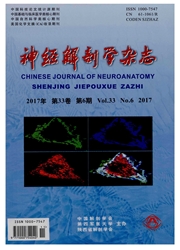

 中文摘要:
中文摘要:
目的:探索通过玻璃体内细胞移植预防和治疗早产儿视网膜病(retinopathy of prematurity,ROP)的可能途径。方法:获取成年大鼠骨髓基质细胞(marrow stromal cells,MSC),并连续传代。应用免疫组织化学和ELISA技术检测MSC中及MSC条件培养基(MSC-CM)中生长因子的表达。通过体外检测内皮细胞增殖、迁移和管腔形成确认MSC—CM的作用。将DiI标记的MSCs细胞移植入氧诱导视网膜病(oxygen induced retinopathy,OIR)模型小鼠玻璃体腔。应用免疫荧光技术检测神经或胶质细胞分布与分化标志。采用视网膜整装片ADP酶组织化学染色和视网膜前内皮血管细胞核计数方法评估新生血管的抑制作用。转染血管内皮生长因子(vascular endothelial growth factor,VEGF)干扰RNA质粒的MSCs验证VEGF的保护作用。结果:体外培养的MSCs表达VEGF,胰岛素生长因子(insulin-like growth factors,IGF)和神经生长因子(nerve growth factor,NGF)。MSC-CM促进体外培养内皮细胞的增殖,迁移和管型形成。发现眼内移植后,标记的MSCs聚集在视网膜前的玻璃体内,或者整合入视网膜,并表达胶质纤维酸性蛋白(glial fibrillary acidic protein,GFAP)。吸入高氧前玻璃体内注射MSCs能显著缓解视网膜新生血管。体外和体内研究证实转染VEGF干扰RNA质粒的MSCs后其保护作用减弱。结论:在OIR早期移植MSCs能显著减少新生血管形成。VEGF等因子的旁分泌,可能在此过程发挥重要作用;通过细胞移植保护视网膜血管可以作为治疗ROP的潜在途径。
 英文摘要:
英文摘要:
Objective To explore a possible preventive and therapeutic measure for the retinopathy of prematurity(ROP) via intravitreal cell transplantation. Methods: Marrow stromal cells (MSC) were got from adult rat and by con-tinuing passage. The expression of growth factors was detected in situ by immunohistochemistry or in MSCs conditionedmedium (MSC-CM) by ELISA. Effects of MSC-CM were confirmed by in vitro assays for endothelial cell proliferation,migration and tubogenesis. CM-DiI labeled MSCs were intravitreal transplanted to the mouse model of oxygen induced reti-nopathy (OIR). The distribution and possible differentiation were monitored under a fluorescence microscopy by immuno-histochemistry to specific markers of neurons or glia. The alleviation of neovascularization was evaluated by retina wholemount stained with ADPase histochemisty, and by pre-retina nuclei counts in serial sections. MSCs transfeeted with plasmid encoding siRNA for vascular endothelial growth factor (VEGF) was used to clarify the possible role of VEGF accountfor the protective effects. Results: VEGF, insulin-like growth factors (IGF) and nerve growth factor (NGF) was defected in. culture MSCs. MSC-CM promoted proliferation, migration and tubogenesis of endothelial cell in vitro. Afterintraoeular transplanted, labeled MSCs Were found aggregated in vitreous in front of the retina, or incorporated to retinaand expressing glial fibrillary acidic protein (GFAP). Intravitreal injection of MSCs before hyperoxia drastically relievedthe retinal neovaseularization. After transfeeted the MSCs with plasmid encoding siRNA for VEGF, the protective effectsof MSCs were attenuated both in vitro and in vivo. Conclusion : MSCs transplantation during the first stage of OIR drasti-cally relieve the later neovascularization. Paraerine, such as VEGF secretion, may play an important role in this process.Protecting the retinal vessels via eell transplantation is a potential avenue for treatment or prevention of ROP.
 同期刊论文项目
同期刊论文项目
 同项目期刊论文
同项目期刊论文
 期刊信息
期刊信息
